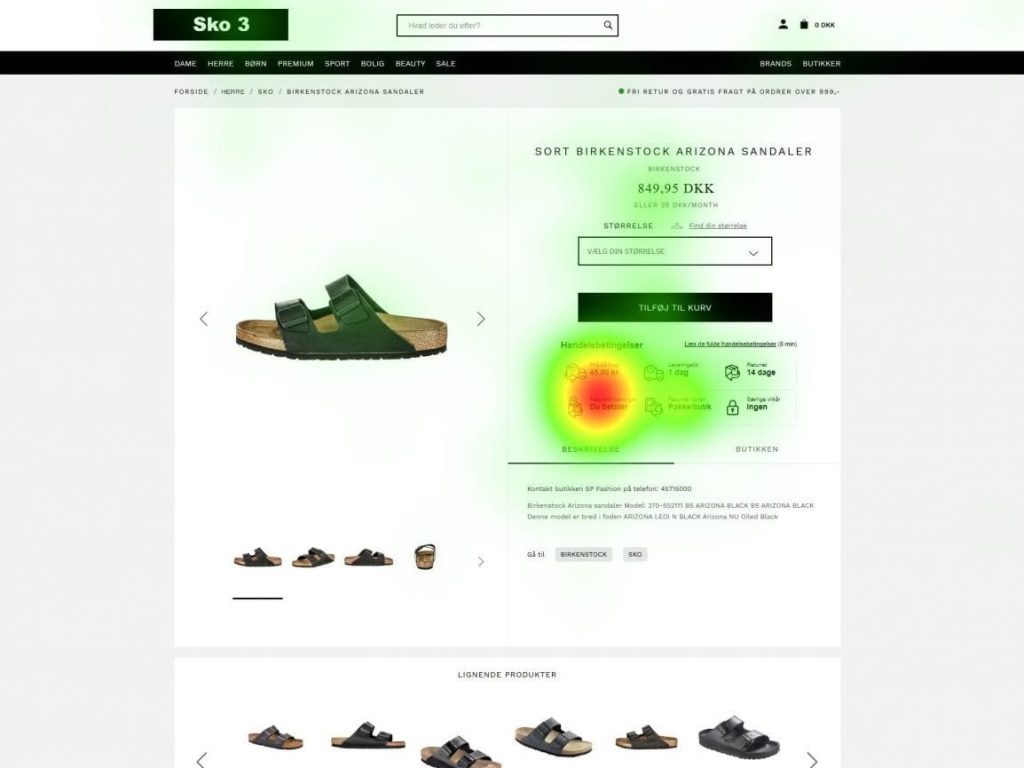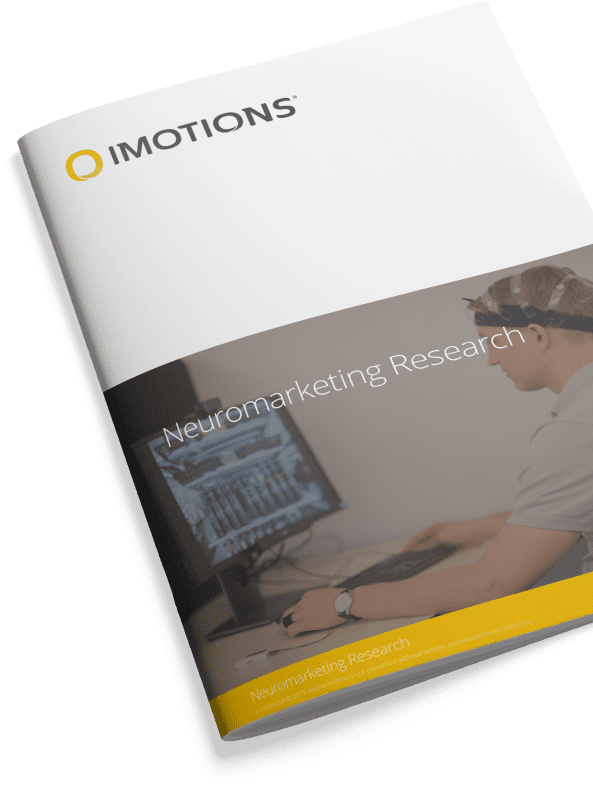Every human feeling, thought, and action is the result of neural activity in the brain. Behind all of our abstract definitions, we are biological beings run purely by biochemical processes. If all our actions are accompanied by physiological markers, this means that the internal processes behind our feelings, thoughts, and actions can be studied. This is what the discipline of neuromarketing does in a nutshell. In this article, you can read more information about how neuromarketing software can advance behavioral research and deepen your understanding of your customers and research participants.
What is neuromarketing?
Thoughts and emotions are hidden, abstract concepts.
But not so much anymore. The discipline of neuromarketing – a field emerging at the intersection of neuroscience, psychology, and marketing – analyses human sentiments to predict, understand, and study human behavior. While doing this, neuromarketing offers insights into how the brain responds to products, services, media, and other stimuli.
In short, neuromarketing helps brands understand their customers better by studying their unconscious emotional reactions, decision-making, and purchasing behaviors. It achieves this by using various neuroimaging tools such as facial coding, eye tracking, biometrics, fMRI, or implicit response tests.
Key Features of Neuromarketing Software
Neuromarketing software simplifies complex emotional reactions and turns them into data. It merges insights gained from various research tools to create a clearer picture of how someone is feeling or how they are reacting. Here are some other benefits of using neuromarketing software in your business.
Eye tracking analytics
People’s gaze reveals a lot about their interests, intentions, and emotions. This is what eye-tracking is studying. It collects data about eye movements and translates them into behavioral insights. Eye tracking is an essential tool integrated into neuromarketing software, which provides key analytics into how much time people are spending looking at certain areas of a product, avoiding certain triggers, or displaying a special interest in a situation. This is a key component of understanding someone’s interests and reaction to a stimulus.

Facial expression analysis
Facial expression analysis (FEA) offers a mirror into people’s inner world. Using fully automated computer algorithms that detect and analyze facial expressions, FEA captures emotional reactions in real-time, without relying on subjective interpretation or self-report.
Since the face is an essential component in the understanding of customer behavior, neuromarketing software solutions use facial expression analysis tools to show how people react when exposed to certain products, advertising, or sales techniques. Facial expression analysis has numerous applications in research, marketing, neuroscience, psychology, and customer service. Recognizing facial expressions can, when used in the right contexts, be an accurate indicator of emotional experiences.
Real-time data synchronization and multi-modal capabilities
Another feature of neuromarketing software solutions is their multi-modal component. They allow you to collect and analyze human behavior data through multiple neuroimaging tools, such as eye tracking, galvanic skin response, facial expression analysis, EEG, EMG, and ECG, and streamline the data from these tools on one single platform. Combining multiple measures of human behavior will lead to a clearer picture of someone’s internal world and their emotional reactions.
The Power of iMotions in Enhancing Neuromarketing Research
iMotions is the world’s leading provider of neuromarketing software solutions. Integrating an ecosystem of biosensor technology and data analysis solutions, iMotions provides actionable data to help researchers and marketers advance their understanding of human behavior.
Optimizing consumer experience
People do not always verbalize when they are displeased with a product or service. They might not be consciously aware that something is wrong, aside from a feeling of something being not quite right, which is rarely an actionable insight. In research or customer service, this can block efforts to truly understand a client or participant.
Luckily it is impossible not to show how you feel about a certain thing entirely. Emotional cues will involuntarily show on a person’s face, in their heart rate and brain activity, which indicates the nonconscious feelings of participants. iMotions can help unlock insights that are hidden from plain sight. To provide the right products, services, or customer experiences, tailored to the client’s unique needs and preferences, businesses need to get to know the people they are interacting with and this means looking at their subtle emotional reactions, and brain activity, or assessing their stress level.
The neuromarketing software solutions offered at iMotions allow you to create a better and more customized customer experience that makes people feel seen and understood.
Uncovering subconscious responses and emotional triggers
The limitation of verbal feedback is that it does not tap into the more nuanced emotional experience of the customer. Oftentimes, those nonconscious emotions and triggers say the most about someone. For example, when someone sees something they completely dislike while trying to keep a neutral face. In this case, knowing the person’s preferences by looking at their unconscious responses can ensure that such stimuli are avoided in the future.
With the tools offered by iMotions such as facial expression analysis and face expression recognition, EEG, eye tracking, and EDA, you can capture deeper emotional experiences from your research participants or customers. This will give you access to more robust data about their behavior, decision-making process, and intentions.

Improving advertising effectiveness
Highly efficient advertising begins with knowing the customer inside out. Without a complete understanding of what happens in someone’s brain when they scroll through a web page or interact with a new product, marketing is likely to be an estimated guess at best.
Capturing real-time data of what happens in a customer’s mind when they try a service for the first time can create lasting results for businesses and marketing departments. With data from biosensor technology, one can even make predictions about how the same customer will respond to future advertising.
The iMotions neuromarketing software solutions help you tap into the brain activity occurring outside your customer’s conscious awareness and deliver the advertising techniques that respond to that exact brain activity.
Getting Started with the Best Neuromarketing Software
Neuromarketing, at its core, is about delving deep into the subconscious reactions of consumers to marketing stimuli. In the ever-evolving world of marketing, understanding these neural cues is imperative for the success of campaigns. One of the pivotal technologies powering neuromarketing is eye tracking, and when integrated with neuromarketing software, it provides unparalleled insights into customer behavior. Specifically, when discussing eye tracking neuromarketing software, iMotions Neuromarketing Software solutions often takes center stage, offering a comprehensive suite of tools that can significantly enhance your marketing campaign.
Frequently Asked Questions: Neuromarketing
Q: Is neuromarketing ethical?
A: The ethics of neuromarketing have been a subject of debate among marketers, researchers, and the general public. On one hand, neuromarketing offers companies a deeper insight into consumer preferences, allowing for more tailored and effective advertising. On the other hand, there are concerns about manipulating consumer behavior by tapping into their subconscious desires and triggers. Ethical considerations include:
- Informed Consent: Participants in neuromarketing research should be fully aware of the nature of the studies and provide informed consent.
- Data Privacy: The sensitive neural and biometric data collected should be safeguarded with the utmost care, ensuring participant anonymity and data security.
- Transparency: Companies should be open about the use of neuromarketing techniques in their campaigns.
- Ultimately, like many tools, the ethics of neuromarketing depends largely on how it is used. Ensuring transparency, privacy, and respect for consumers’ autonomy can address many ethical concerns.
Q: How does neuromarketing work?
A: Neuromarketing blends neuroscience with marketing research. It works by monitoring brain activity and other physiological responses of individuals when they are exposed to marketing stimuli, such as ads, products, or brands. Some of the key techniques include:
Brain Imaging: Technologies like fMRI and EEG are used to monitor brain activity patterns when subjects interact with or think about a product or brand.
Eye Tracking: This measures where individuals look, how long they gaze at certain spots, and the sequence of their gaze, providing insights into visual attention and preferences.
Galvanic Skin Response (GSR): This captures the electrical conductance of the skin, which can indicate levels of emotional arousal.
Facial Coding: By analyzing facial expressions, marketers can gauge emotional reactions to stimuli, from joy and surprise to anger and disgust.
By analyzing this data, marketers gain insights into what truly captures consumer interest, evokes emotions, or drives purchase decisions.
Q: What are some popular neuromarketing examples?
A: Neuromarketing has been employed in various successful campaigns and product developments. Some popular examples include:
- Frito-Lay: The company used neuromarketing research to discover that shiny packaging and loud chip crunch sounds were off-putting to female consumers. This led to the development of a quieter and more discreet snack packaging for certain products targeted at women.
- Campbell Soup: Campbell’s used eye-tracking studies to revamp their soup can labels. The research showed that consumers had a strong connection to the iconic ‘Campbell’s’ script, but their gaze drifted elsewhere on the label. As a result, the company made the script more prominent in their redesign.
- Google: Google utilized eye tracking to optimize their search result layouts, ensuring that ads and sponsored results received optimal attention without detracting from user experience.
- Cheetos: Through neuromarketing research, the brand discovered that consumers enjoyed the messy residue left by the snack because it was part of the ‘rebellious’ experience of eating Cheetos. This insight led to campaigns that embraced the messy fun.
These examples demonstrate the power of neuromarketing in informing design, product development, and advertising strategies.
Conclusion
Neuromarketing measures brain activity and other physiological signals to provide insights into someone’s mind and behavior. This can be particularly beneficial in client-centric settings that need to respond to a variety of interests and preferences. As the world’s leading provider of human insights, iMotions can help you advance your research and marketing goals with its software research suite. It integrates biosensor technology to create a robust neuromarketing software solution. If you want to find out more information about our platform and tools, get in touch with our team.
Download iMotions Neuromarketing Brochure
iMotions is the world’s leading biosensor platform.
Learn more about how iMotions can help you with your neuromarketing work and research












